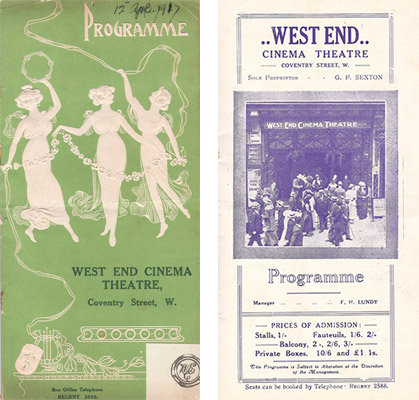The West End Cinema Theatre, later the Rialto, opened on 18 March 1913. It was the most architecturally ambitious cinema in the West End yet built, seating nearly 700 people on two levels under a central dome, and costing in excess of £40,000 to construct and furnish. A red neon sign on its frontage, supposedly the first anywhere in Britain, lit up the area around Coventry Street with the words ‘West End’.1 It occupied a prime location, between Leicester Square and Piccadilly Circus, and close to the famous Lyons Corner House tearooms. Beneath the cinema, in the basement level, was the Café Elysée restaurant, later reopened as the fashionable Café de Paris nightclub.2
Despite this prestigious location, after Britain entered World War I in August 1914, the West End Cinema faced an attack on its custom. In a series of articles, the London Evening News claimed that the cinema, which was part of a chain owned by London and Provincial Electric Theatres, Limited, was siphoning money to the enemy. Several of the company’s directors and a number of its shareholders lived in Germany or were of German descent. In a display of nationalism and anti-German sentiment, the newspaper called for a boycott of all ‘German Picture Theatres’ in Britain, including the West End Cinema.3 The call came at a time when Germans living in London faced losing their jobs or the threat of physical assaults.
Although it didn’t face rioting, the West End Cinema was apparently hit hard by the boycott.4 But, by May 1915, according to a film trade correspondent, it was ‘up to its old form’. It had the same manager (William L. Ker), but a new owner (G.F. Sexton), with ‘the entire alien interest, which aroused such hostility after the outbreak of war, eliminated’.5 A programme for the cinema from around this time got the message across to any customers with long memories by declaring on its front cover that the cinema was ‘Entirely British – in Ownership and Management’.6 The cinema continued to advertise its patriotism throughout the remainder of the war, with benefit screenings for war charities and free entry for wounded soldiers.
Image: Programme for the West End Cinema Theatre, 12 April 1917.
Further reading:
- Allen Eyles with Keith Skone, London’s West End Cinemas, third edition (Swindon: English Heritage, 2014).
- Panikos Panayi, ‘Anti-German Riots in London during the First World War’, German History, 7:2 (1989), 184-203.
- Jerry White, Zeppelin Nights: London in the First World War (London: Bodley Head, 2014).
- Allen Eyles with Keith Skone, London’s West End Cinemas, third edition (Swindon: English Heritage, 2014), p. 55. ↩
- Horace Wyndham, Nights in London: Where Mayfair Makes Merry (London: Bodley Head, 1926), pp. 33-4. ↩
- ‘German Picture Theatres’, Evening News, 13 August 1914. Similar articles appeared throughout the following week. ↩
- ‘War’s Black Mark’, Moving Picture World, 12 September 1914, p. 1515: http://archive.org/stream/movingpicturewor21newy#page/1514/mode/2up. ↩
- ‘Our Weekly Visits to London Shows’, Kinematograph and Lantern Weekly, 27 May 1915, p. 29. ↩
- Programme for the West End Cinema Theatre, week beginning 3 May 1915, Cinema Museum, London. ↩



